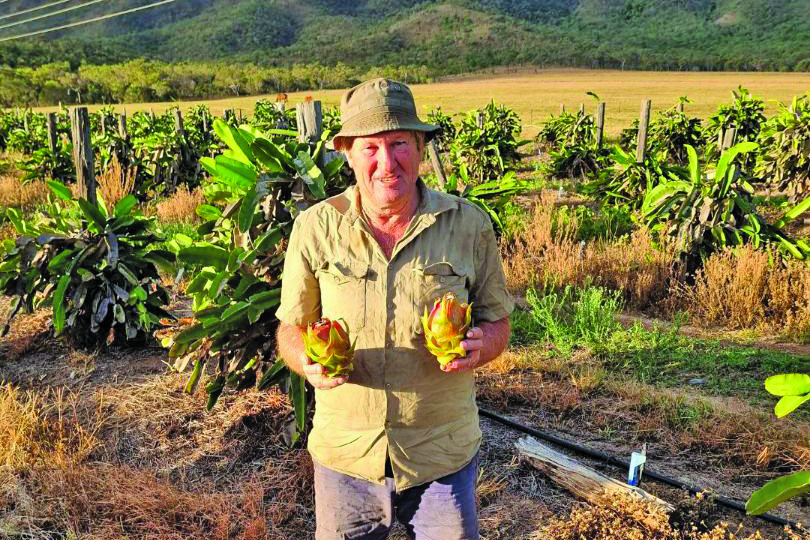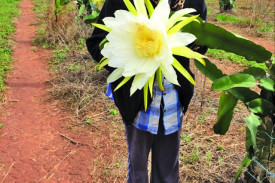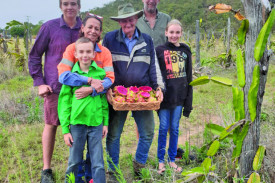On The Land
11 August, 2023
Fruitful idea grows into family farming venture
When John Price watched a documentary on Landline about dragon fruit 15 years ago, little did he realize that he would now have around 2700 dragon fruit plants which provide one sixth of his farming income on his Spring Mount property.

Along with his lime plantation, cattle, hay and occasional pumpkin or corn crop, dragon fruit have proved to be a valuable addition to his family’s farming income.
After the idea first caught his attention, his research led him to a Department of Primary Industries (DPI) agent in Gordonvale who was selling the seed stock.
Both he and his wife Wendy subsequently purchased 1000 cuttings and commenced their first plantings in 2008.
Today, after cutting and multiplying his dragon fruit plants since initially purchasing them, he now has 900 posts in the ground with three plants per post, totaling an area of around one hectare.
Dragon fruit grower Angela Nason who is involved in her family’s farming operation said her father Charlie Price watched his eldest brother's success and decided to plant some dragon fruit vines himself six years ago.
“He has a smaller plantation to that of his brother and today now has 300 posts and 900 dragon fruit vines on Chewko Road, on the outskirts of Mareeba,” Angela said.
With the family dragon fruit operations spanning across Spring Mount and Mareeba, John Price’s one hectare plantation can return $20,000 on a good year while Charlie Price’s one quarter of a hectare can return between $5,000-$10,000.
John Price says that not one single dragon fruit has been spoiled over this time.
On average, around 2 tonnes of production per year is obtained from his operation.
“There are five farmers in our area who are commercial producers of dragon fruit and have established small crops that we know of and we have heard of other larger farms,” Angela said.
“We call upon these producers to source dragon fruit for our company Tablelands to Tabletop when we can't keep up with demand.”
Native to southern Mexico and Central America, dragon fruit (pitaya) is now grown all over the world including in Australia.
Highly passionate about the fruit and its future, Angela said her research found that although dragon fruit was first introduced into Queensland in 1970, it was not grown commercially until 2013.
“Dragon fruit loves our Far North Queensland tropical climate and the Tablelands offers the perfect growing conditions for it,” Angela said.
It takes eight months to two years for the plant to flower and after this occurs, flowering and fruiting take place four times per year.
Once established, plants can produce for between 20 to 30 years making the initial investment in them extremely worthwhile.
“Dragon fruit require at least six to eight hours of sunlight, full sun is okay but if you are able to provide some shade for the scorching 40 degree hot summer months the vines will love it more, they can get sunburnt,” Angela said.
“Sandy soil is best and ensure that it is well drained as they don't like to sit in water, moist is best.
“Fertilise monthly before fruiting.”
With a bright future ahead of it, the once unknown dragon fruit has now become one of the newest fruits to hit the spotlight on the Atherton Tablelands.
Named because the fruit bears the resemblance of a dragon, with the spikes also looking like the fire that a dragon breathes, this unique and delectable fruit was also given the honour of being chosen as this year’s Queensland Country Women’s Association (QCWA) ‘Primary Product of the Year for 2023’.
“There are around 20 varieties of dragon fruit, some are red-fleshed while others are white-fleshed,” Angela said.
“Typically the most popular is the red skin/red flesh, then you have red skin/white flesh, yellow skin/white flesh and red skin/purple flesh.”
“Packed with all the benefits of being high in vitamin C and high in fibre, dragon fruit also has a low GI.
“It is ideal for diabetics.”
Dragon fruit can be enjoyed in many ways and this versatile fruit can be chopped and frozen for future use and convenience.
“Fresh is best, chilled is favourable and a squeeze of lime gives it a further delicious tang,” Angela said.
“Our family favourite is a frozen dragon fruit, frozen banana, milk and yoghurt smoothie.
“You can hide a cup of spinach in it for that added nutritional benefit and the smoothie doesn't even change in colour or taste.
“Any fruit that is considered to be less than ideal goes to a local ice cream making factory in Cairns to make delicious dragon fruit ice cream.”
Purchases of dragon fruit can be made in store and look online for delivery across FNQ.
For further information, contact Angela Nason at Tablelands to Tabletop on 0419 719 487 or email to tablelandstotabletop@gmail.com




